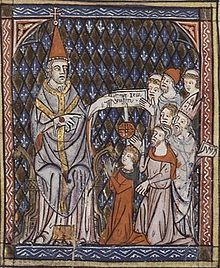Pope Callixtus I
About Calixt I (also Callist I. , Calixt I. Calixtus I or Callixtus I; * possibly c. 160; † 222), bishop of Rome from 217 to 222, little is known. His tenure was during the reigns of the Roman emperors Elagabal and Severus Alexander.
His name (κάλλιστος kállistos) means "the most beautiful" (Greek/Latin).
St. Hippolytus of Rome, a contemporary and adversary of Calixt, tells the following about him: As a young slave, Calixt was appointed by his master to supervise a bank - but he lost the money entrusted to him by other Christians. He fled Rome, but was seized on a ship. To escape slavery, he jumped ship. He was rescued and brought back to Carpophorus, but at the intercession of his believers he was set free. They hoped he would be able to recover some of the money. But he was arrested again when a fight broke out in a synagogue. Calixt had been trying to collect debts or borrow money. He was now sent to the mines of Sardinia.
In 190 Calixt was acquitted with Hippolytus of Rome and some other Christians at the request of Marcia, a concubine of the Emperor Commodus. His health, however, was so failing that he was sent to Antium, where he recovered and received a pension from Bishop Victor I.
As a bishop, Calixt I forgave newly baptized people their penance for sins committed before baptism. His rigorist contemporary Hippolytus, a Roman catechist who styled himself in his writings as the counter-bishop of the less strict Calixt I, polemicized against this decision and the possibility, scandalous in his eyes, that former murderers, adulterers and fornicators were allowed to participate in the meal services of Christians without proper penance.
Furthermore, Calixt stood up against the heresy of Sabellius, the modalistic monarchianism, whereby Hippolytus again accused him of not being zealous enough against it.
It is possible that Calixt died as a martyr around 222, perhaps during a popular uprising. But there is no evidence for the legend according to which he was thrown into a well at the site of the present church of San Callisto. He was buried in the cemetery of Calepodius on the Via Aurelia. His relics were transferred to the Abbey of Cysoing near Tournai in the 9th century, and later also to Reims, Fulda, Naples and several churches in Rome.
After his death, the presbyter Hippolytus, as the head of Ditheism, once again allowed himself to be raised to the position of Bishop of Rome. Although he was unable to assert himself against the recognized Urban I and then Pontianus, he continued to assert himself as the counter-bishop of the Schism of Hippolytus, which was named after him, until 235.
The Roman Calixtus Catacomb, which he administered as a deacon before becoming bishop, is named after Calixt. He is venerated as a martyr in Todi, Italy, and his memorial day is 14 October. In art he is usually depicted wearing a red robe and a tiara, or with a millstone around his neck. There is often a fountain near him.

Pope Calixt gives instructions on fasting (French miniature to the Legenda Aurea, 14th century)
Search within the encyclopedia